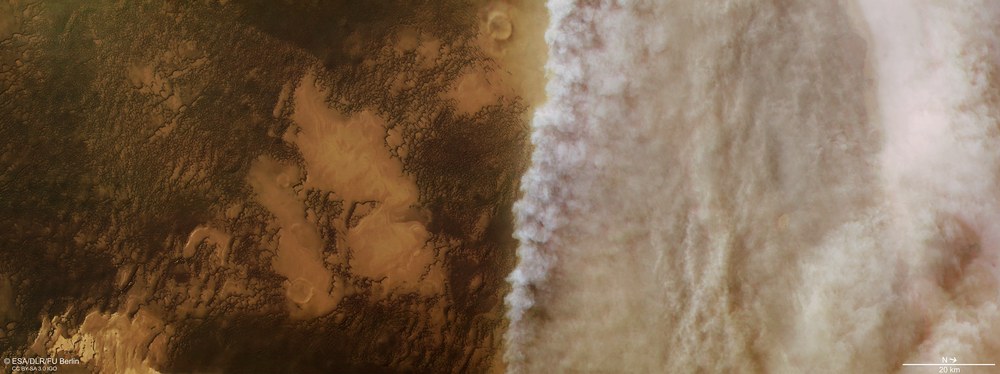Harbinger of the 2018 dust storm season on Mars


- Images acquired by the DLR-operated HRSC camera in April 2018 show a local dust storm on Mars
- Dust storms on Mars have less than half the wind speed of hurricanes on Earth, due to the lower atmospheric pressure on Mars
- Focus: Space, planetary research
These images show a local dust storm with a towering cloud front, located close to the northern polar region of the Red Planet. This storm, which started in April 2018, is just one of several local dust storms that have been observed on Mars in recent months. The images were created using data acquired by the High Resolution Stereo Camera (HRSC) on board ESA's Mars Express orbiter. The camera system is operated by the German Aerospace Center (Deutsches Zentrum für Luft- und Raumfahrt; DLR).
The small, local dust storm front shown here is located north of Utopia Planitia, close to the ice cap at the Martian North Pole. Another, far larger storm emerged in Arabia Terra in late May of this year, and within a few weeks it developed into a planet-wide dust storm. This latter storm is one of the most severe storms ever observed on Mars and is currently being observed by all five active ESA and NASA spacecraft (2001 Mars Odyssey, Mars Reconnaissance Orbiter, Mars Atmosphere and Volatile EvolutioN (MAVEN), Mars Express, Exomars Trace Gas Orbiter).
Local and regional dust storms are frequent events on Mars, but only a few of them develop into global phenomena that might persist for several months. These storms only occur every three to four Martian years, which is equivalent to approximately six to eight Earth years. Although dust storms on Mars are very impressive, the lower atmospheric pressure means that they are less powerful than tropical storms on Earth and only reach around half the wind speed of a hurricane.
The NASA orbiters Mariner 9 (1971), Viking I (1977) and Mars Global Surveyor (2001) have observed massive dust storms in the past. The one captured by Mariner 9 was particularly impressive, because after the orbiter entered Mars orbit, the first images it transmitted back to Earth did not show any surface features. Only the top of an enormous, global dust storm was visible, with just the 24-kilometre-high summit of Olympus Mons visible above the cloud layer. Later on, Mariner 9 was able to capture the first 'dust-free' global satellite images.
Dust storms statistically occur more frequently in the north, during autumn and winter, when Mars nears perihelion – its closest approach to the Sun. As it moves along its elliptical orbit around the Sun, Mars is exposed to more light when it is near perihelion. This causes the atmosphere to heat up and winds to form.
Only very little sunlight reaches the Martian surface during the storm, such that the solar panels of NASA's Opportunity rover cannot supply energy at the moment. The rover therefore automatically switched into power conservation mode and shut down communications in June 2018. At the same time, NASA's Curiosity rover remains able to explore the surface of Mars and observe the development of the storm because it is powered by a radioisotope thermoelectric generator rather than solar panels.
Scientists expect the global dust storm to weaken significantly by late autumn this year. Even if a lot of dust and aerosols remain in the atmosphere, this will not affect the landing of the NASA InSight spacecraft on 26 November 2018, according to the US space agency. InSight has been on its way to the Red Planet since 5 May 2018 and is carrying an experiment provided by DLR on board.
Image processing
The High Resolution Stereo Camera (HRSC) acquired the image data on 3 April 2018, during Mars Express orbit 18,039. The image resolution is approximately 16 metres per pixel. The centre of the image is located at approximately 106 degrees east and 78 degrees north. The colour overhead view was created using data acquired by the HRSC nadir channel, the field of view of which is aligned perpendicular to the Martian surface, and the colour channels. The anaglyph image, which gives a three-dimensional impression of the landscape when viewed with red-blue or red-green glasses, was derived from data supplied by the nadir channel and one stereo channel. The systematic processing of the camera data took place at the DLR Institute for Planetary Research in Berlin-Adlershof. Staff in the Department of Planetary Science and Remote Sensing at Freie Universität Berlin used the data to create the image products shown here.
The HRSC experiment on board Mars Express
The High Resolution Stereo Camera was developed at the German Aerospace Center (Deutsches Zentrum für Luft- und Raumfahrt; DLR) and built in collaboration with partners in industry (EADS Astrium, Lewicki Microelectronic GmbH and Jena-Optronik GmbH). The science team, which is headed by Principal Investigator (PI) Ralf Jaumann, consists of 52 co-investigators from 34 institutions and 11 countries. The camera is operated by the DLR Institute of Planetary Research in Berlin-Adlershof.
